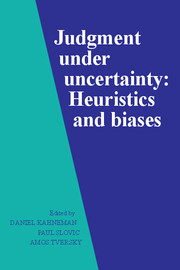Book contents
- Frontmatter
- Contents
- List of contributors
- Preface
- Part I Introduction
- Part II Representativeness
- Part III Causality and attribution
- Part IV Availability
- Part V Covariation and control
- Part VI Overconfidence
- Part VII Multistage evaluation
- Part VIII Corrective procedures
- 28 The robust beauty of improper linear models in decision making
- 29 The vitality of mythical numbers
- 30 Intuitive prediction: Biases and corrective procedures
- 31 Debiasing
- 32 Improving inductive inference
- Part IX Risk perception
- Part X Postscript
- References
- Index
32 - Improving inductive inference
Published online by Cambridge University Press: 05 May 2013
- Frontmatter
- Contents
- List of contributors
- Preface
- Part I Introduction
- Part II Representativeness
- Part III Causality and attribution
- Part IV Availability
- Part V Covariation and control
- Part VI Overconfidence
- Part VII Multistage evaluation
- Part VIII Corrective procedures
- 28 The robust beauty of improper linear models in decision making
- 29 The vitality of mythical numbers
- 30 Intuitive prediction: Biases and corrective procedures
- 31 Debiasing
- 32 Improving inductive inference
- Part IX Risk perception
- Part X Postscript
- References
- Index
Summary
In this chapter, we discuss the possibility of improving people's inferences in everyday life. Nisbett and Ross (1980) proposed that improvements could result from making the inferential tools of the scientist available to the layperson in the form of inferential maxims, such as “It's an empirical question,” or “You can always explain away the exceptions.” We shall refer to “statistical heuristics” for some of the most important of these informal guides to reasoning, such as “Think about evidence as if it were a sample, and reflect about sample size.” We believe that such rough inferential guides, when embedded in a matrix of understanding of statistics and probability theory and when buttressed by experience in applying the heuristic to concrete problems, may prove to be of great value in reducing inferential error in daily life.
It is possible to be systematic in an examination of what could be accomplished by such a program and where difficulties are likely to be encountered. We believe that three such difficulties are clearly visible now, and we believe that attempts to solve each of the problems will pay dividends in terms of extending our understanding both of how people infer and of how they ought to infer.
- Type
- Chapter
- Information
- Judgment under UncertaintyHeuristics and Biases, pp. 445 - 460Publisher: Cambridge University PressPrint publication year: 1982
- 21
- Cited by



